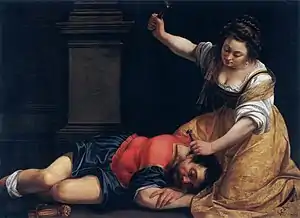Jael and Sisera (Artemisia Gentileschi)
Jael and Sisera is a painting by the Italian baroque artist Artemisia Gentileschi, executed around 1620. The topic of the canvas is taken from the Book of Judges, verses 4:11-22 and 5:24-31. It depicts the moment in which Jael is about to kill Sisera, a defeated Canaanite general. After his defeat he flees to a nearby settlement. There Jael takes him in, promises to feed him, and hide him from the authorities. The moment he is asleep she drives a tent peg through his temple. This subject is seldom depicted in seventeenth century art, there very few other examples contemporary to this painting.
| Jael and Sisera | |
|---|---|
 | |
| Artist | Artemisia Gentileschi |
| Year | 1620 |
| Medium | oil paint, canvas |
| Dimensions | 86 cm (34 in) × 125 cm (49 in) |
| Location | Museum of Fine Arts |
| Accession No. | 75.11 |
The date, 1620 can be seen at the bottom of the Artist's prominent signature, carved in to the pillar. [1] While the date places Artemisia in Rome, she signs this painting, "Artemisia Lomi," suggesting a Florentine patron. While living and working in Florence, Artemisia adopts this surname, which belonged to one of her uncles, rather than the Roman Gentileschi, to strengthen her ties the city among her potential patrons. [2]
Aside from this clue the source of patronage for this painting is unknown. The prominence of the artist's signature indicate that this was a work she felt worthy of praise. The three-line signature reads, "ARETEMITA LOMI/FACIBAT/MDCXX." This is the first example of Artemisia using the imperfect tense of the Latin verb Facibat, perhaps a reference to the way in which Michelangelo signed his Pieta. [3]
This painting was restored in 1978 by Veronika Ember. Prior to restoration the painting had extensive paint loss in the upper left and lower right hand corners. As a result of the restoration the highlights on Sisera skirt were strengthened and some of the shadows are more mechanical in nature than those you would expect to see by Artemisia's hand. The signature remained intact.[4]
The painting currently hangs in the Szepmuveszeti Museum, Budapest.[5]
References
- Christiansen, K., Mann, Judith Walker, Gentileschi, Orazio, Gentileschi, Artemisia, Museo di Palazzo Venezia, & Metropolitan Museum of Art. (2001). Orazio and Artemisia Gentileschi. New York : New Haven: Metropolitan Museum of Art ; Yale University Press.
- Judith W. "Identity signs: meanings and methods in Artemisia Gentileschi's signatures." Renaissance Studies 23, no. 1 (February 2009): 71-107. Academic Search Premier, EBSCOhost (accessed March 16, 2018).
- Judith W. "Identity signs: meanings and methods in Artemisia Gentileschi's signatures." Renaissance Studies 23, no. 1 (February 2009): 71-107. Academic Search Premier, EBSCOhost (accessed March 16, 2018).
- Bissell, R. (1999). Artemisia Gentileschi and the authority of art : Critical reading and catalogue raisonné. University Park, Pa.: Pennsylvania State University Press.
- Christiansen, Keith; Mann, Judith Walker (2001). Orazio and Artemisia Gentileschi. New York; New Haven: Metropolitan Museum of Art ; Yale University Press. ISBN 1588390063.